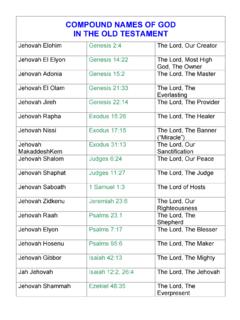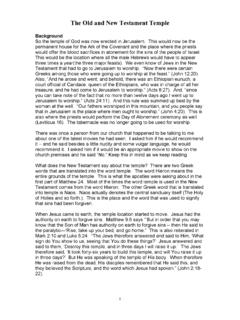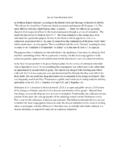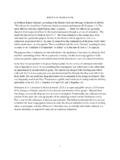Transcription of Galatians in the Greek New Testament by Kenneth Wuest
1 Galatians in the Greek New Testament by Kenneth Wuest This work is licensed under a Creative Commons Attribution-Noncommercial-No Derivative Works United States License Dedicated To John C. Page, , my honored and beloved instructor in Bible Doctrine and Homiletics during student days at the Moody Bible Institute, whose masterful teaching technique, clear exposition of the Word, and humble Christian life redolent with the fragrance of the Lord Jesus, have left their deep impression upon my life and ministry. PREFACE. The story of this book can be summed up in the following words: Other men have labored. The author has entered into their labors. Whatever original work the writer has done, concerns itself chiefly with the ministry of the Holy Spirit and its relationship to the spiritual situation in the Galatian churches at the time of the inroads of the Judaizers, a theme which the commentaries do not treat adequately.
2 Seven authorities on the Greek New Testament were consulted as the writer studied the words, phrases, and sentences of the text, and others were brought in when needed. Where portions are quoted verbatim, due recognition has been given the particular author, but the writer has for the most part made the material his own, and has put it in words which the average Bible student can understand. The seven authorities in their alphabetical order are: Henry Alford, The Greek Testament ; Ernest DeWitt Burton, A Critical and Exegetical Commentary on St. Paul's Epistle to the Galatians ; Bishop J. B. Lightfoot, Saint Paul's Epistle to the Galatians ; Heinrich Meyer, Critical and Exegetical Commentary on the New Testament ; Frederic Rendall in Expositor's Greek Testament ; A. T. Robertson, Word Pictures in the New Testament , and Marvin R. Vincent, Word Studies in the New Testament . The supplementary authorities are: Joseph H.
3 Thayer, Greek -English Lexicon of the New Testament ; James Hope Moulton and George Milligan, Vocabulary of the Greek Testament ; Herman Cremer, Biblico-Theological Lexicon of New Testament Greek ; Liddel and Scott, Greek -English Lexicon (classical); Archbishop Trench, New Testament Synonyms; H. E. Dana, and Julius R. Mantey, A Manual Grammar of the Greek New Testament ; Henry C. Thiessen, Introduction to the New Testament , and Theodor Zahn, Introduction to the New Testament . The writer has made available to the student of the English Bible, a wealth of interpretive and translation material from these authorities to which he otherwise would have no access (with the exception of Robertson's Word Pictures), and he has tried to present it in language which the average student is able to follow. Many of the Greek words commented upon have been included in their transliterated form for those who are conversant with the Greek New Testament .
4 This is no book to peruse in one's easy chair. It is designed like its predecessors, Philippians in the Greek New Testament , and First Peter in the Greek New Testament , for use on the Christian's study table alongside of his Bible. The book is a simplified commentary on the Greek text of Galatians , making available to the Bible student who is not acquainted with Greek , and who has had no formal training in Bible study, a wealth of informative and explanatory material that will throw a flood of light upon his English Bible. The translation offered is what might be called a fuller translation, using more words than a standard version of the Scriptures in order to bring out more of the richness of the Greek , and make certain passages clearer, where the condensed literality of the standard translations tends to obscure their meaning. Words in parenthesis are not part of the translation but are explanatory.
5 The translation must not be used as a substitute for, but as a companion to the standard translation the student is using. The book is not written for the scholar, and lays no claim to being a finished piece of work on the Greek text of Galatians . It is designed for those who love the Lord and His Word and delight in feasting upon it. The index makes it possible for the student to turn quickly to any verse desired. Where a word or subject is treated more fully or in its every New Testament occurrence in the author's other books, a footnote will direct the reader to the page or pages where that treatment may be found. The English translation referred to is the Authorized Version. The Greek text used is Nestle's. K. S. W. 1. The Historical Background of the Letter Before entering upon an exegetical study of Paul's Galatian letter, we must consider the following questions: first, Where were the Galatian churches located?
6 ; second, Who were the Galatians ?; and third, Who were the Judaizers and what did they teach? First, then, as to the location of the Galatian churches. Some have held that these churches were situated in that section of Asia Minor designated on the map as Galatia, in which are situated the cities of Pessinus, Ancyra, and Tavium. This is known as the North Galatian theory. Others hold that these churches were located in the cities of Pisidian Antioch, 1 Iconium, Lystra, and Derbe. This is the South Galatian theory. The first theory had a clear field until Sir William M. Ramsay, a traveller in Asia Minor and a student of the Book of Acts, demonstrated that the Roman province of Galatia included at the time of the founding of the Galatian churches, not only the territory of Galatia, but also the country immediately to the south of it in which were situated the cities of Pisidian Antioch, Iconium, Lystra, and Derbe.
7 In 278 277 , a people known as the Gauls left their home in southern Europe and settled in northern Asia Minor. After 232 , their state became known as Galatia. King Amyntas (35 25 ), the last independent ruler of Galatia, bequeathed his kingdom to Rome, and Galatia became a Roman province, 25. During the first century, the term Galatia was used in two different senses: geographically, it referred to the territory in the northern part of the central plateau of Asia Minor where the Gauls lived; and politically, it was used to designate the Roman province of Galatia as it varied in extent. There was a wide difference between North and South Galatia in respect to language, occupation, nationality, and social organization. The northern section was still mainly populated by the Gauls, and was pastoral, with comparatively little commerce and few roads. But in South Galatia the situation was radically different.
8 This section was full of flourishing cities, and was enriched by the constant flow of commerce across it. This was the natural result of its geographical position and political history. In ancient times it was the highway along which Asiatic monarchs kept up their communications with the western coast of Asia Minor. When Greek monarchs ruled in Syria and Asia Minor, the highway between their capitals, Syrian Antioch and Ephesus, passed through South Galatia, and was the principal channel through which Greek civilization flowed eastward. These monarchs planted colonies of Jews and Greeks along the extent of this highway. The Caesars inherited the policy of the Greek monarchs, and planted fresh colonies along this road in order to secure this important route to the east for their legions and their commerce. Dr. Henry Clarence Thiessen, , , , chairman of the Department of Bible, Theology, and Philosophy at Wheaton College, Wheaton, Illinois, an authority among evangelical scholars, says in his most excellent book, Introduction to the New Testament , that now all scholars agree that Paul was in the province of Galatia when he on his first missionary journey visited Antioch, Iconium, Lystra, and Derbe (Acts 13:1 14:28).
9 He says that Sir William Ramsay has proved this conclusively, and that no one today disputes the assertion. Dr. Thiessen also states that it seems clear that Paul on his second missionary journey (Acts 15:36 18:22). went through North Galatia (Acts 16:6) after he had passed through South Galatia, Luke using the term Galatian in its territorial sense. On his third journey, he visited the disciples in North Galatia made on the second journey (Acts 18:23). Dr. Thiessen remarks that it is significant that Luke uses the word disciples rather than churches in connection with Paul's visit to North Galatia on his third journey. The implication is clear that the Galatian churches as such were in South Galatia and that there were only scattered disciples in the north section. Paul, Dr. Thiessen says, always used the provincial names of the districts that were under the Roman domination, never the territorial, except as the two were identical in significance.
10 He speaks of Achaia, Macedonia, Illyricum, Dalmatia, Judaea (in the Roman sense of Palestine), Arabia, and Asia as provinces. Dr. Thiessen asks some significant questions, the obvious answers to which point to the opinion that, as he says, the Galatian letter was written primarily to the churches of Pisidian Antioch, Iconium, Lystra, and Derbe. First, is it likely since Paul alway used the provincial names of districts, that he would speak of Galatia in any other sense? Second, would it not be strange for Luke to tell us so much about the founding of churches in South Galatia (Acts 13:14 14:23), and for Paul to say nothing about them? Third, does it not seem strange, on the other hand, to think that Paul would write so weighty a letter as the Epistle to the Galatians to churches whose founding is practically passed over in silence by Luke, as would be the case if the Galatian churches were located in North Galatia?





